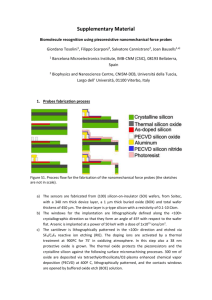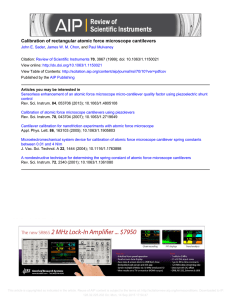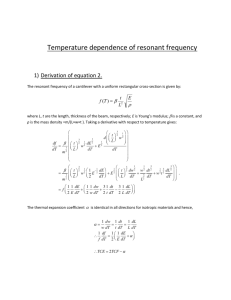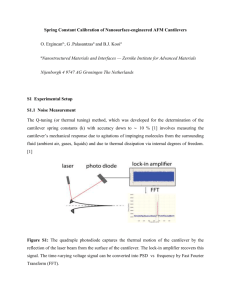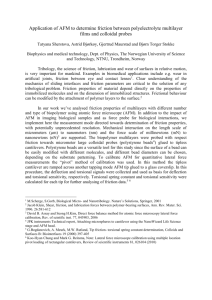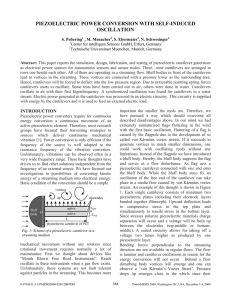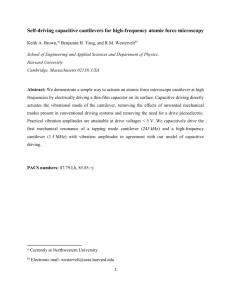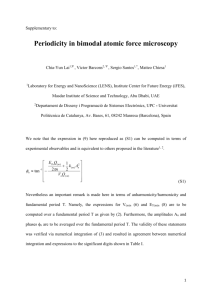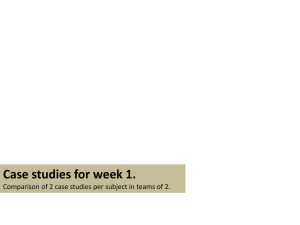Supplementary information
advertisement
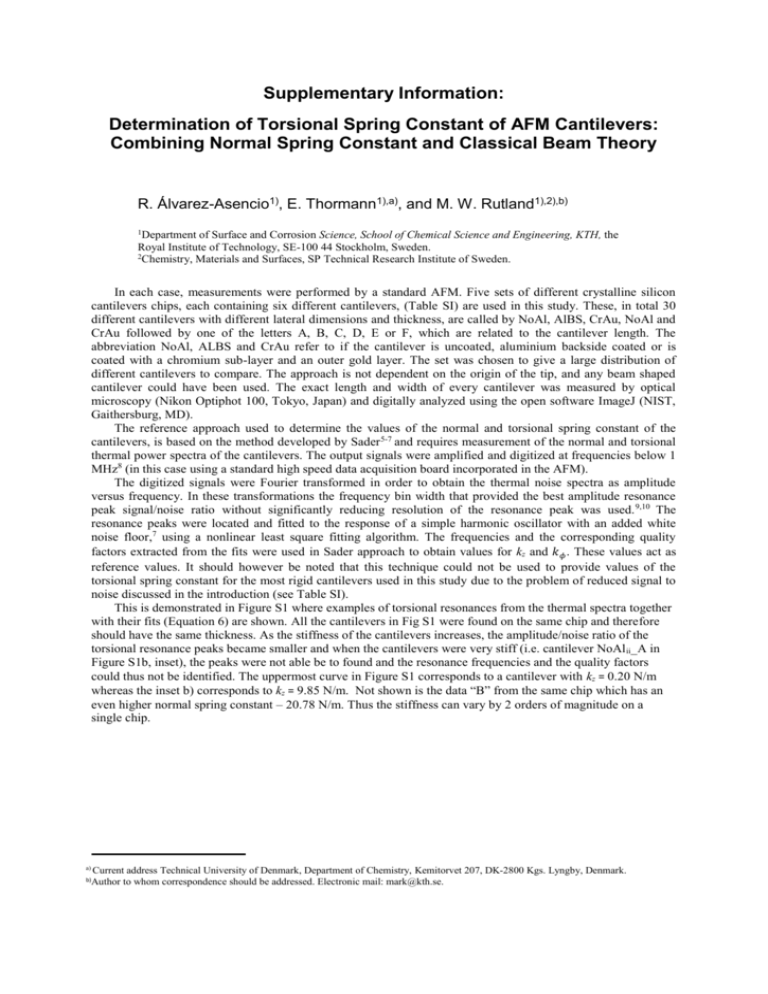
Supplementary Information: Determination of Torsional Spring Constant of AFM Cantilevers: Combining Normal Spring Constant and Classical Beam Theory R. Álvarez-Asencio1), E. Thormann1),a), and M. W. Rutland1),2),b) 1Department of Surface and Corrosion Science, School of Chemical Science and Engineering, KTH, the Royal Institute of Technology, SE-100 44 Stockholm, Sweden. 2Chemistry, Materials and Surfaces, SP Technical Research Institute of Sweden. In each case, measurements were performed by a standard AFM. Five sets of different crystalline silicon cantilevers chips, each containing six different cantilevers, (Table SI) are used in this study. These, in total 30 different cantilevers with different lateral dimensions and thickness, are called by NoAl, AlBS, CrAu, NoAl and CrAu followed by one of the letters A, B, C, D, E or F, which are related to the cantilever length. The abbreviation NoAl, ALBS and CrAu refer to if the cantilever is uncoated, aluminium backside coated or is coated with a chromium sub-layer and an outer gold layer. The set was chosen to give a large distribution of different cantilevers to compare. The approach is not dependent on the origin of the tip, and any beam shaped cantilever could have been used. The exact length and width of every cantilever was measured by optical microscopy (Nikon Optiphot 100, Tokyo, Japan) and digitally analyzed using the open software ImageJ (NIST, Gaithersburg, MD). The reference approach used to determine the values of the normal and torsional spring constant of the cantilevers, is based on the method developed by Sader 5-7 and requires measurement of the normal and torsional thermal power spectra of the cantilevers. The output signals were amplified and digitized at frequencies below 1 MHz8 (in this case using a standard high speed data acquisition board incorporated in the AFM). The digitized signals were Fourier transformed in order to obtain the thermal noise spectra as amplitude versus frequency. In these transformations the frequency bin width that provided the best amplitude resonance peak signal/noise ratio without significantly reducing resolution of the resonance peak was used. 9,10 The resonance peaks were located and fitted to the response of a simple harmonic oscillator with an added white noise floor,7 using a nonlinear least square fitting algorithm. The frequencies and the corresponding quality factors extracted from the fits were used in Sader approach to obtain values for kz and 𝑘𝜙 . These values act as reference values. It should however be noted that this technique could not be used to provide values of the torsional spring constant for the most rigid cantilevers used in this study due to the problem of reduced signal to noise discussed in the introduction (see Table SI). This is demonstrated in Figure S1 where examples of torsional resonances from the thermal spectra together with their fits (Equation 6) are shown. All the cantilevers in Fig S1 were found on the same chip and therefore should have the same thickness. As the stiffness of the cantilevers increases, the amplitude/noise ratio of the torsional resonance peaks became smaller and when the cantilevers were very stiff (i.e. cantilever NoAl ii_A in Figure S1b, inset), the peaks were not able be to found and the resonance frequencies and the quality factors could thus not be identified. The uppermost curve in Figure S1 corresponds to a cantilever with kz = 0.20 N/m whereas the inset b) corresponds to kz = 9.85 N/m. Not shown is the data “B” from the same chip which has an even higher normal spring constant – 20.78 N/m. Thus the stiffness can vary by 2 orders of magnitude on a single chip. a) b) Current address Technical University of Denmark, Department of Chemistry, Kemitorvet 207, DK-2800 Kgs. Lyngby, Denmark. Author to whom correspondence should be addressed. Electronic mail: mark@kth.se. TABLE SI: Average spring constants of the cantilevers based on three repetitions and their standard deviations (SD) for the cantilevers used in this work are provided. These spring constants were calculated by the Sader equation (Sader), Simplified Hybrid or Hybrid methods. 𝐻𝑦𝑏𝑟𝑖𝑑 𝑆𝑖𝑚𝑝𝑙𝑖𝑓𝑖𝑒𝑑 𝐻𝑦𝑏𝑟𝑖𝑑 Cantilever t/L/w (µm) 𝑘𝑍𝑆𝑎𝑑𝑒𝑟 (N/m) SD 𝑘𝑍𝑆𝑎𝑑𝑒𝑟 𝑘𝜙𝑆𝑎𝑑𝑒𝑟 (N∙m/rad) SD 𝑘𝜙𝑆𝑎𝑑𝑒𝑟 𝑘𝜙 (N∙m/rad) SD 𝐻𝑦𝑏𝑟𝑖𝑑 𝑘𝜙 ALBS_A 1/106/26.0 0.57 0.02 2.80E-09 3.12E-11 3.32E-09 1.26E-10 2.86E-09 1.09E-10 ALBS_B 1/86/26.1 1.07 0.15 3.72E-09 9.92E-11 4.27E-09 5.80E-10 3.53E-09 4.80E-10 ALBS_C 1/125.5/25.8 0.28 0.00 1.78E-09 6.93E-12 2.24E-09 6.85E-12 1.98E-09 6.06E-12 ALBS_D 1/294/27.3 0.03 0.00 1.65E-09 3.07E-10 1.22E-09 3.05E-11 1.16E-09 2.90E-11 ALBS_E 1/346/27.5 0.02 0.00 9.62E-10 2.39E-11 9.74E-10 4.49E-11 9.33E-10 4.30E-11 ALBS_F 1/245.5/27.0 0.05 0.00 1.15E-09 1.20E-11 1.45E-09 3.64E-11 1.36E-09 3.42E-11 NoAli_A 1/108/29.7 1.22 0.06 7.04E-09 7.74E-10 7.50E-09 3.99E-10 6.33E-09 3.36E-10 NoAli_B 1/88.5/29.7 2.64 0.06 1.05E-08 7.33E-10 1.14E-08 2.47E-10 9.20E-09 2.00E-10 NoAli_C 1/125.6/29.6 0.63 0.03 5.07E-09 3.54E-10 5.13E-09 2.20E-10 4.45E-09 1.91E-10 NoAli_D 1/298.7/30.5 0.04 0.00 1.48E-09 6.21E-11 1.63E-09 6.78E-11 1.54E-09 6.41E-11 NoAli_E 1/351/30.4 0.02 0.00 1.14E-09 2.95E-11 1.38E-09 1.72E-10 1.32E-09 1.65E-10 NoAli_F 1/250/30.6 0.07 0.01 1.88E-09 3.39E-11 2.05E-09 1.51E-10 1.91E-09 1.41E-10 CrAui_A 1/118.5/29.2 1.44 0.02 7.62E-09 1.61E-10 1.04E-08 1.26E-10 8.96E-09 1.08E-10 CrAui_B 1/100.5/29.5 2.54 0.10 9.95E-09 2.45E-10 1.37E-08 5.46E-10 1.14E-08 4.55E-10 CrAui_C 1/137.5/30.0 0.75 0.02 5.40E-09 2.31E-11 7.19E-09 2.30E-10 6.31E-09 2.02E-10 CrAui_D 1/308.3/29.2 0.04 0.00 1.68E-09 6.24E-11 1.91E-09 6.36E-11 1.81E-09 6.04E-11 CrAui_E 1/359/29.3 0.03 0.00 1.60E-09 2.80E-11 1.60E-09 1.05E-10 1.54E-09 1.01E-10 𝑘𝜙 (N∙m/rad) SD 𝑆𝑖𝑚𝑝𝑙𝑖𝑓𝑖𝑒𝑑 𝐻𝑦𝑏𝑟𝑖𝑑 𝑘𝜙 CrAui_F 1/258/29.5 0.08 0.00 1.98E-09 1.20E-10 2.45E-09 1.11E-10 2.30E-09 1.04E-10 CrAuii_A 1/114.9/32.4 6.24 0.35 4.53E-08 1.23E-09 4.36E-08 2.47E-09 3.66E-08 2.07E-09 CrAuii_B 1/94.5/32.2 10.86 1.16 5.74E-08 6.86E-09 5.35E-08 5.71E-09 4.31E-08 4.60E-09 CrAuii_C 1/133.4/32.6 3.50 0.12 2.97E-08 5.01E-09 3.21E-08 1.13E-09 2.77E-08 9.78E-10 CrAuii_D 1/294/29.3 0.19 0.00 5.92E-09 1.58E-10 7.57E-09 2.08E-11 7.16E-09 1.97E-11 CrAuii_E 1/344.2/29.3 0.11 0.01 5.58E-09 3.80E-10 6.13E-09 3.41E-10 5.85E-09 3.26E-10 CrAuii_F 1/256.3/29.5 0.31 0.07 6.58E-09 2.08E-10 9.58E-09 2.13E-09 8.98E-09 1.99E-09 NoAlii_A 2/101.5/33.5 9.85 1.24 - - 5.56E-08 6.97E-09 4.51E-08 5.66E-09 NoAlii_B 2/80.8/33.0 20.78 0.19 - - 7.87E-08 7.01E-10 6.03E-08 5.37E-10 NoAlii_C 2/120.3/32.4 4.59 0.28 3.21E-08 3.71E-09 3.49E-08 2.12E-09 2.95E-08 1.80E-09 NoAlii_D 2/280.5/32.3 0.30 0.03 1.10E-08 5.60E-10 1.14E-08 1.03E-09 1.06E-08 9.68E-10 NoAlii_E 2/330.5/31.6 0.20 0.02 9.22E-09 6.69E-10 1.01E-08 7.81E-10 9.58E-09 7.41E-10 NoAlii_F 2/230/31.9 0.60 0.04 1.44E-08 6.90E-10 1.52E-08 9.33E-10 1.40E-08 8.62E-10 FIG. S1. Torsional resonance frequencies of several cantilevers obtained from the thermal spectra with their respective fits to the simple harmonic oscillator function. For clarity, the resonance frequencies have been shifted to the same position in the figure where the width of the window corresponds to 10 kHz. For the curve NoAlii_C the value of the resonance frequency is 998.7 kHz and for NoAlii_E is 374.5 kHz. Inset (a) shows the torsional resonance peak of the cantilever NoAlii_C. Inset (b) shows the frequency region where the torsional resonance peak of the cantilever NoAlii_A should be located. 1 R. J. Roark and W. C. Young, Formulas for Stress and Strain (McGraw-Hill, Nee York, 1975). R. G. Cain, S. Biggs, and N.W. Page, J. Colloid Interface Sci. 227, 55 (2000). 3 D. Faoite, D. Browne, F. Chang-Díaz and S. Kenneth, J. Mat. Sci. 47, 4211 (2012). 4 J. E. Sader, Rev. Sci. Instrum. 74, 2438 (2003). 5 J. E. Sader, I. Larson, P. Mulvaney, and L. R. White, Rev. Sci. Instrum. 66, 3789 (1995). 6 C. P. Green, H. Lioe, J. P. Cleveland, R. Proksch, P. Mulvaney, and J. E. Sader, Rev. Sci. Instrum. 75, 1988 (2004). See also http://www.ampc.ms.unimelb.edu.au/afm/calibration.html. 7 J. E. Sader, J. W. M. Chon, and P. Mulvaney, Rev. Sci. Instrum. 70, 3967 (1999). 8 W. M. J. Chon, P. Mulvaney, and E. J. Sader, J. Appl. Phys. 87, 3978 (2000). 9 J. E. Sader, J. A. Sanelli, B. D. Hughes, J. P. Monty and E. J. Bieske, Rev. Sci. Instrum. 82, 095104 (2011). 10 J. E. Sader, B. D. Hughes, J. A. Sanelli and E. J. Bieske, Rev. Sci. Instrum. 83, 055106 (2012). 2
